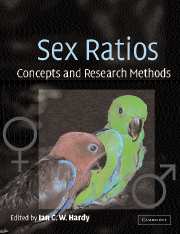Book contents
- Frontmatter
- Contents
- List of contributors
- Preface and acknowledgements
- Part 1 Sex ratio theory
- Part 2 Statistical analysis of sex ratio data
- Part 3 Genetics of sex ratio and sex determination
- Part 4 Animal sex ratios under different life-histories
- Part 5 Sex ratios in plants and protozoa
- Part 6 Applications of sex ratios
- Chapter 18 Operational sex ratios and mating competition
- Chapter 19 Using sex ratios: the past and the future
- Chapter 20 Using sex ratios: why bother?
- Index
- References
Chapter 20 - Using sex ratios: why bother?
Published online by Cambridge University Press: 06 August 2009
- Frontmatter
- Contents
- List of contributors
- Preface and acknowledgements
- Part 1 Sex ratio theory
- Part 2 Statistical analysis of sex ratio data
- Part 3 Genetics of sex ratio and sex determination
- Part 4 Animal sex ratios under different life-histories
- Part 5 Sex ratios in plants and protozoa
- Part 6 Applications of sex ratios
- Chapter 18 Operational sex ratios and mating competition
- Chapter 19 Using sex ratios: the past and the future
- Chapter 20 Using sex ratios: why bother?
- Index
- References
Summary
Summary
Many see research into sex allocation as the jewel in the crown of evolutionary ecology. There is a very rich experimental literature providing qualitative, and in some cases quantitative, support for the predictions of numerous theoretical models. Consequently, it might be argued that future work will primarily be concerned with dotting i's and crossing t's. Given that there are still so many relatively untamed areas in evolutionary biology, we should therefore ask – why bother with more sex-allocation studies? Our aim in this chapter is to address this question (why?), complementing the more methodological (how?) parts of this book. We argue that sex allocation is an excellent model trait for examining general questions in evolutionary biology.
The usefulness of sex allocation
The strength of sex-allocation research arises for both theoretical and empirical reasons. Sex allocation has a direct and potentially large influence on fitness, and the relevant trade-offs are easy to quantify. Consequently, optimality models are able to make clear theoretical predictions in many specified cases. Empirically, sex allocation can be a relatively easy trait to measure. This is especially true in cases where males and females are equally costly to produce, and so we can concern ourselves simply with the sex ratio (defined as proportion males, i.e. males/(males+females)). In this case, all we must do is count the number of male and female offspring that are produced.
- Type
- Chapter
- Information
- Sex RatiosConcepts and Research Methods, pp. 399 - 413Publisher: Cambridge University PressPrint publication year: 2002
References
- 13
- Cited by



